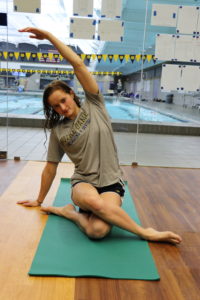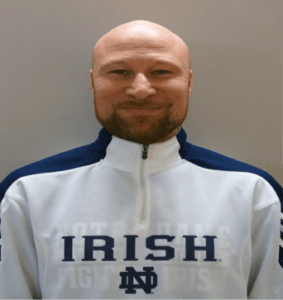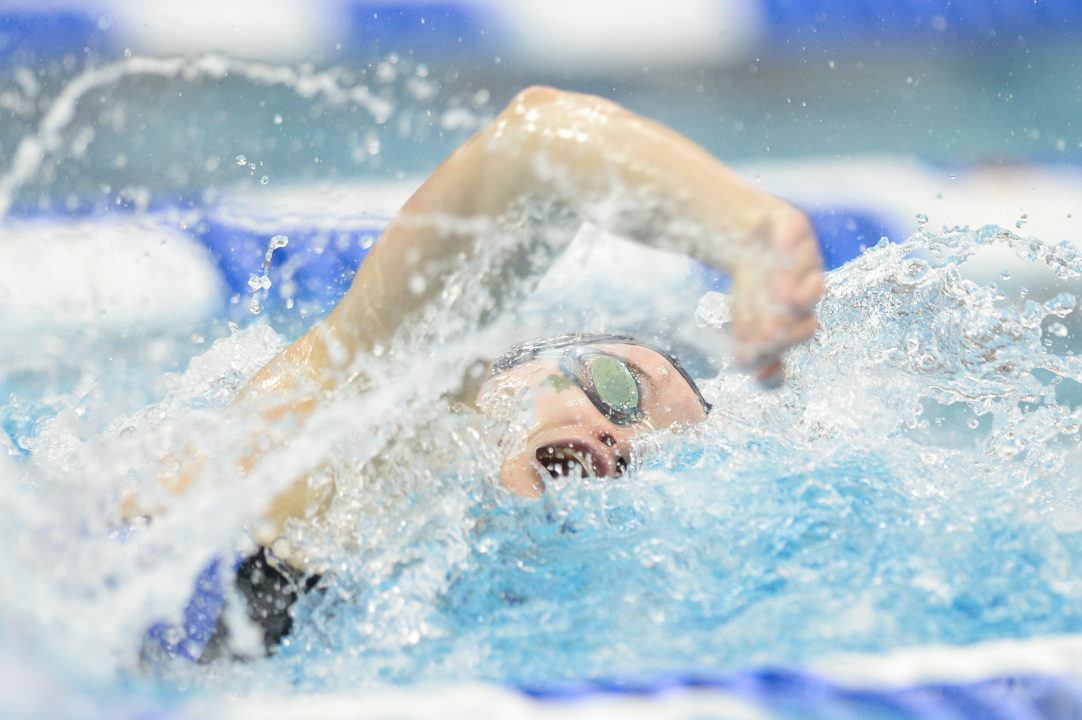This post was written by guest contributor Steve Krojniewski who is a yoga instructor at the University of Notre Dame. Steve works with several of the university’s athletic teams including men’s and women’s swimming and diving.
Swimming is one of the most grueling competitive sports in the world. The dedication that it takes for swimmers to reach the finals at their Conference Championship or the NCAAs is extremely challenging. It is even more difficult to reach the finals at the Mount Olympus of the swimming world, the Olympics.
The sport isn’t just taxing on the physical body, but even more, it may be very draining for swimmers emotionally and mentally. As coaches we know that this sport is demanding, but the average person doesn’t. They don’t understand that a swimmer covers an average of 5000/6000 yards/meters during morning practice. For some, it’s then off to class to make a huge impact as an outstanding student at their universities. They return to being an athlete after class as they hit the weight room or for dry land workouts. Then it’s time for one more session at the pool for another 6000/7000 yards to cap off the day.
So with such a tough schedule, is there any other way a coach can support their swimmer to recover from the stress of the classroom, weight room, and the pool? The answer may come from an ancient practice from the past that is making huge strides in the swimming world today. Yoga.
When a swimmer introduces yoga into their training cycle, they will increase strength and stability to their shoulders. Another advantage of using yoga is the additional flexibility to their latissimus dorsi, obliques, and to the quadratus lumborum. This extra flexibility helps to decrease muscle strains and chronic inflammation to both the back and the shoulders. These physical benefits will assist a swimmer by gaining a faster recovery time by decreasing the delayed on-set of muscle stiffness (DOMS) effect that comes along with training and competition.
Another perk from adding yoga to the training cycle is focused breathing exercises that will increase the parasympathetic nervous system (PSNS). Having a raised PSNS will initiate a “calming state” in the swimmer’s mind when they are placed in stressful situations in the weight room, at practice or at a meet. This raised PSNS will also cut down on sleep disturbances, as the calming mental state will lead to a more restful night’s sleep allowing the mind and body to recover from their workouts.
As the Yoga Sports Coach for the University of Notre Dame’s swimming program, I feel great pride in assisting our swimmers with a yoga recovery program that will help them to be their best, during the off-season as well as the championship season. Here is one yoga sequence that I do that helps target the needs I mentioned above.
1) Savasana on a rolled up blanket
Take a blanket and fold it up to a 3-foot rectangle shape. Roll it up into a tight cylinder shape and tuck it under to support your head. After placing it behind you (making sure you’re not sitting on it), tie a strap around the mid torso and lie back on the blanket. You can have your legs out straight, knees bent, or bring the bottom of your feet together and allow the knees fall out to the side. Stay here for 3 minutes continuing to deepen your breath. Keep your mind focused on counting to 5, then exhale slowly for a 5 count and repeat. This breathing exercise will help to calm your mind and body to decrease stress. When you’re ready, roll off the blanket to your right and push yourself up to move to the next pose.

2) Cow facing pose
Sit on the ground with the right leg crossed over the left leg (you may need to sit on a blanket or a block if your hips are tight). Additionally you may need to sit with ankles crossed if you are extremely tight in the hips or if you can’t sit with legs crossed. Take the arms out to a t-position and have a strap in your left hand. Externally rotate your left arm, take the arm behind the head and dangle the strap behind the head. Internally rotate the right arm and take the arm under and then up the back. Grab the strap and bring the hands as close together as possible. Press the head into the left forearm, squeeze the shoulder blades together and gently pull down on the strap with the right hand. Stay here for 7-10 breaths and then release out of the pose.

3) Cow facing lateral dip
Sit on the ground with the right leg crossed over the left leg (you may need to sit on a blanket or a block if your hips are tight) and extend the left arm up overhead. Press your left sitz bone firmly down, dip to the right and place your right hand on the ground. Keep extending through the left fingers and make sure you don’t collapse on the right side of your body. Stay here for 7-10 breaths, then inhale back up and release out of the pose.

4) Cow facing forward fold
Sit on the ground with the right leg crossed over the left leg (you may need to sit on a blanket or a block if your hips are tight). Additionally you may need to sit with ankles crossed if you are extremely tight in the hips or if you can’t sit with ankles crossed. Lift the arms overhead and slowly begin to fold forward. You may want to place a block or two under your head to support it. Stay here for 7-10 breaths and release out of the pose.

5) Seated spinal twist
Sit on the ground with the right leg crossed over the left leg, placing the bottom of the right foot in contact with the ground (you may need to extend your left leg if this flexion hurts the left knee). Wrap the left arm around the right knee, gently twist right and place the right hand on a block. Stay here for 7 to 10 breaths, then inhale back up and release out of the pose.

Repeat the seated sequence on the other side and end back where you started in savasana. Stay there for 5-10 minutes and then go refuel and hydrate for maximum recovery.
TRUE BALANCE YOGA + NOTRE DAME ATHLETICS
Steve is the owner of True Balance Yoga and the leading yoga instructor at the University of Notre Dame. Steve is a certified Kripalu Yoga instructor and also has received additional training; he’s received certification from the Sage Rountree School for Yoga for Athletes and from the Institute of Yoga Sports Science. He is currently working extensively with the Notre Dame swimming and diving program, the women’s soccer team, and the men’s basketball team. He has worked with the women’s lacrosse team, men’s lacrosse team, men’s baseball team, softball team, women’s golf, the cheerleading squad, and members of the football, cross country/track, and volleyball teams during his tenure.
Steve is a prAna Ambassador and has teamed with prAna to teach clinics for athletes nationally and internationally. He has been a registered yoga teacher for over 15 years and has over 18,000 hours of teaching experience. He is also a Certified Licensed Massage Therapist and received his training at the Holistic Wellness Academy.

Go to http://www.stevekrojo.com to find out more info and practice along on the “Videos” page and follow him on Twitter & Instagram@krojo23.
Model- Abbie Dolan.
- Was named National Swimmer of the Week by CollegeSwimming (Oct. 10) after placing first in three individual races and a relay while leading her team to defeat #7/9 Louisville.
- Was a member of record-breaking 200 free relay team at NCAAs (1:28.81) with her split time best for the Irish of 22.56 (39th overall).
- Named ACC Swimmer of the Week three times.
- CSCAA Scholar All-American.
- Honorable All American at the 2019 NCAA’s
- Set the 100 free school record at the NCAA Championship meet in 48.27 seconds.
- Recorded the fastest 200 free time in program history at the ACC Championships with a 1:43.63 finish.
- Qualified as an individual for two events at the NCAA Championships, advancing to the finals in both the 100 and 200 free races.
- Finished fourth at the conference championships in the 200 free with a time of 1:44.65.
- Set a personal best in the 500 free at the ACC Championships with a time of 4:43.96.
